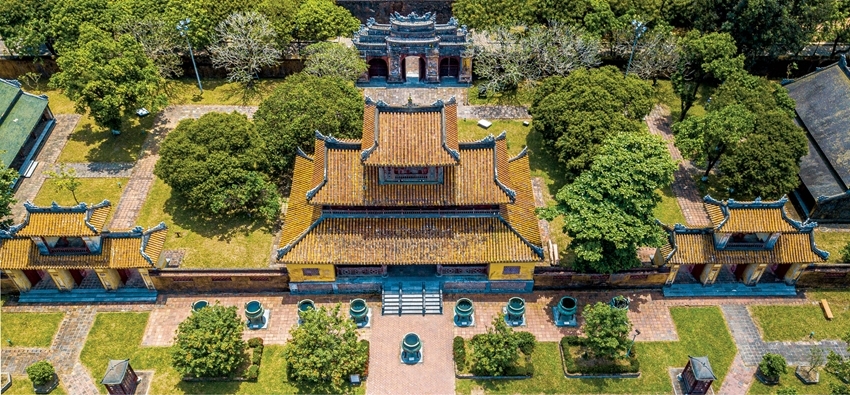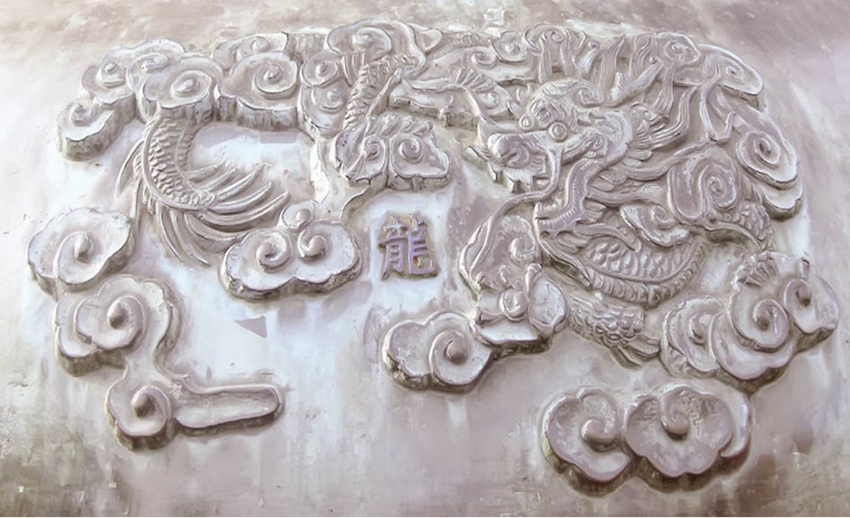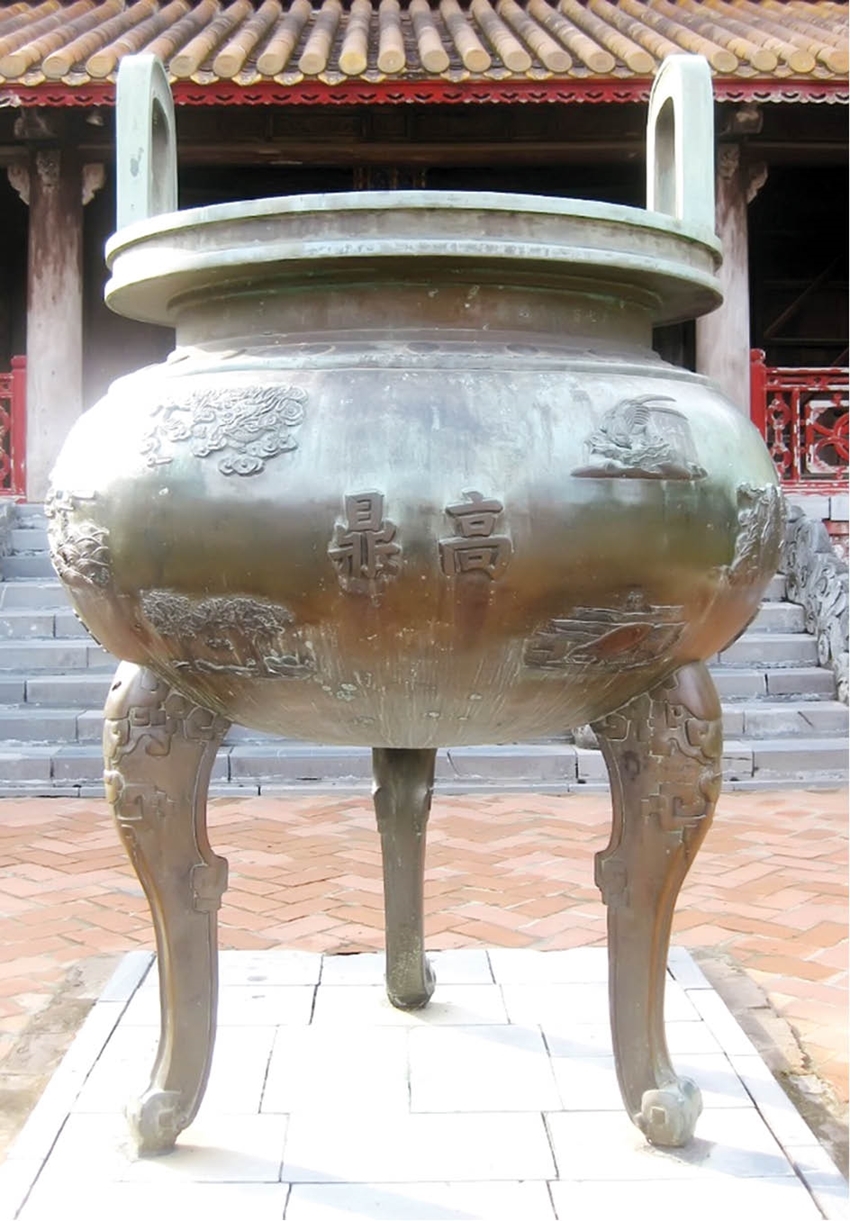According to linguistic researchers, both the Vietnamese word "rồng" and the Chinese word "long" originate from ancient Southeast Asian languages “krong” or “krông”, meaning water or river. The dragon is considered a creature combining characteristics of crocodiles and snakes, born and concealed underwater before soaring into the sky without wings, spewing water or fire. Some archaeologists assert that the dragon is a common symbol among Vietnamese ethnic groups. Specifically, for the Vietnamese, the lively myth about Children of the Dragon and Fairy has existed since the Hung Kings era, thousands of years ago.
 |
| Nine Dynastic Urns at The To Temple. Photo: Ngoc Luc Bao |
According to ancient Vietnamese belief, the Dragon and Fairy represent a pair of yin and yang transformed to explain the ancestral origins of the Vietnamese people. The Fairy symbolizes the bird species, Mother Au Co residing in mountains to lay a hundred eggs. Meanwhile, the Dragon, a creature transformed from a crocodile and snake, resides in rivers and seas, originating from the character of King Father Lac Long Quan, embodying the virtues of loyalty and harmony with agricultural residents. The dragon symbolizes the ancestral roots, deeply embedded in various forms of cultural artifacts to the spiritual life of the Vietnamese people. The dragon quickly became a symbol of power, associated with the supreme image of the king.
Throughout history, the depiction of dragons has somewhat changed in terms of lines and shapes. For example, during the Nguyen dynasty - the last feudal dynasty of Vietnam, the dragon displayed a dignified appearance, symbolizing sacred power. The dragon was depicted in various poses, concealed in clouds, or holding the character "Tho" (Longevity) while flying, or in pairs circling the moon, circling chrysanthemums, circling characters for blessings, longevity... Most of the dragon's body is not elongated but has soft, curvy contours. The head of the dragon is large, with horns resembling deer antlers pointing backwards. The eyes are large, the nose resembles a lion's, and the mouth has sharp fangs. The scales on the back are evenly distributed. The dragon's beard waves from under the eyes, splitting symmetrically. The dragon figure used for kings has five claws, while others have four claws. The dragon symbolizes the strength of the dynasty, so it is commonly adorned on various architectural works in the Imperial City and the tombs of emperors.
 |
| Dragon image carved on Cao Dinh. Photo: Duong Hoang |
It can be said that the dragon is a symbol of sacredness, integrity, strength, representing the will and rise of a nation. According to legend, the carp becomes a dragon due to perseverance in cultivation, surpassing the gate of hardship. During the Dinh dynasty in our country, regardless of the animal, if it "endured hardwork" to achieve righteousness, it could also transform into a dragon.
In 1010, King Ly Thai To chose the land of Thang Long to establish the capital of Dai Viet. This demonstrates that King Ly recognized the "traces" of dragons residing here, carrying the aspirations of the nation to rise and soar. With such beliefs, many regions in Vietnam are named with the word "long", such as Hoang Long, Thang Long, Ha Long, Bai Tu Long, Bach Long Vi, Ham Rong, Ham Long, Hung Long, Cuu Long, Vinh Long, Kim Long... People also have "dragon" horoscopes, born in the year of the dragon (Thìn), which means the creature is ranked fifth in the twelve zodiacs. For the Vietnamese, the dragon is associated with the wish for prosperity, with the symbol of wishing for favorable weather. Therefore, the image of the dragon is often accompanied by the sky, waves...
 |
| Cao Dinh is the largest urn among the Nine Dynastic Urns in front of The To Temple courtyard. Photo: Duong Hoang |
The dragon symbolizes the prosperity and power of the nation, becoming a symbol of the supreme authority of the monarchy, only used in the most solemn places of the palace or major state constructions. In the feudal era, the dragon's image was engraved on royal garments, houses, or royal belongings. However, the vitality of the dragon species is so robust and flexible that it transcends the palace, flying to hidden villages on cliffs, village temple pillars, partitions, pagodas, appearing on ceramic bowls, or even transformed into gatekeepers for temples. The image of the dragon brings luck, creates unrivaled dominance and adaptability in nature. For these reasons, while selecting a site to build Hue Imperial City, our ancestors relied on the perfect symmetrical position bringing natural feng shui elements of "Ta Thanh Long, huu Bach Ho" (Dragon to the left, Tiger to the right) - two symmetric islets on the Huong River, namely Hen Islet and Da Vien Islet, guarding in front of Hue Imperial City.
In 1836, under the 17th Minh Mang reign, when the Nine Dynastic Urns were just cast, the emperor ordered the dragon image to be engraved on the Cao Dinh, placed in the center of The To Temple courtyard within Hue Imperial City. It can be affirmed that this is "the most majestic set of Nine Dynastic Urns ever cast in our country," reaching a very high level in art, technique, and aspirations for a unified nation for generations to come. Therefore, in 2013, the Nine Dynastic Urns were recognized by the Vietnamese state as a "National Treasure."
Today, although the dragon's image no longer carries the sacred and supreme characteristics as before, it is still chosen as a decoration for architectural constructions, paintings, artistic carvings... serving the cultural and spiritual life of humans. In 2024, the Year of the Dragon, the year of the dragon's auspicious beginning, rich in "dragon characteristics," a year of favorable conditions, harmonious rain and wind, abundant harvests, all plans will be successful. From the officials to the people united in one heart, even if there are "thousands of big national issues," it will surely succeed.